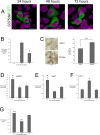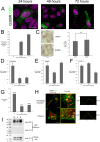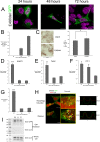Differences in intracellular localisation of ANKH mutants that relate to mechanisms of calcium pyrophosphate deposition disease and craniometaphyseal dysplasia
- PMID: 32366894
- PMCID: PMC7198517
- DOI: 10.1038/s41598-020-63911-x
Differences in intracellular localisation of ANKH mutants that relate to mechanisms of calcium pyrophosphate deposition disease and craniometaphyseal dysplasia
Abstract
ANKH mutations are associated with calcium pyrophosphate deposition disease and craniometaphyseal dysplasia. This study investigated the effects of these ANKH mutants on cellular localisation and associated biochemistry. We generated four ANKH overexpression-plasmids containing either calcium pyrophosphate deposition disease or craniometaphyseal dysplasia linked mutations: P5L, E490del and S375del, G389R. They were transfected into CH-8 articular chondrocytes and HEK293 cells. The ANKH mutants dynamic differential localisations were imaged and we investigated the interactions with the autophagy marker LC3. Extracellular inorganic pyrophosphate, mineralization, ENPP1 activity expression of ENPP1, TNAP and PIT-1 were measured. P5L delayed cell membrane localisation but once recruited into the membrane it increased extracellular inorganic pyrophosphate, mineralization, and ENPP1 activity. E490del remained mostly cytoplasmic, forming punctate co-localisations with LC3, increased mineralization, ENPP1 and ENPP1 activity with an initial but unsustained increase in TNAP and PIT-1. S375del trended to decrease extracellular inorganic pyrophosphate, increase mineralization. G389R delayed cell membrane localisation, trended to decrease extracellular inorganic pyrophosphate, increased mineralization and co-localised with LC3. Our results demonstrate a link between pathological localisation of ANKH mutants with different degrees in mineralization. Furthermore, mutant ANKH functions are related to synthesis of defective proteins, inorganic pyrophosphate transport, ENPP1 activity and expression of ENPP1, TNAP and PIT-1.
Conflict of interest statement
The authors declare no competing interests.
Figures





References
-
- Nurnberg P, et al. Heterozygous mutations in ANKH, the human ortholog of the mouse progressive ankylosis gene, result in craniometaphyseal dysplasia. Nat. Genet. 2001;28:37–41. - PubMed
Publication types
MeSH terms
Substances
Supplementary concepts
Grants and funding
LinkOut - more resources
Full Text Sources
Medical
Molecular Biology Databases
Miscellaneous

